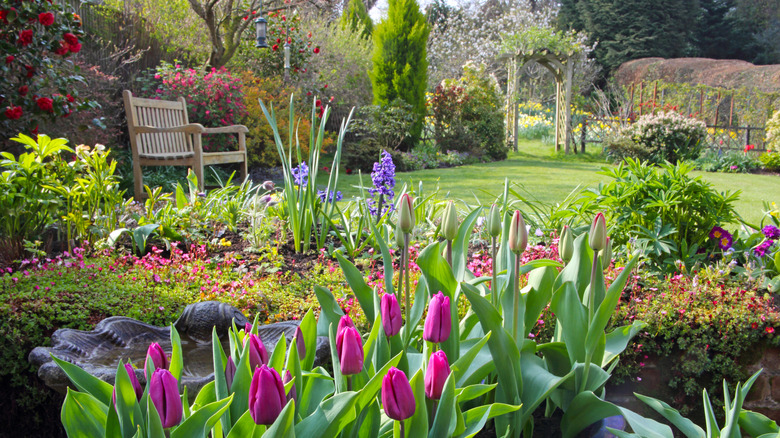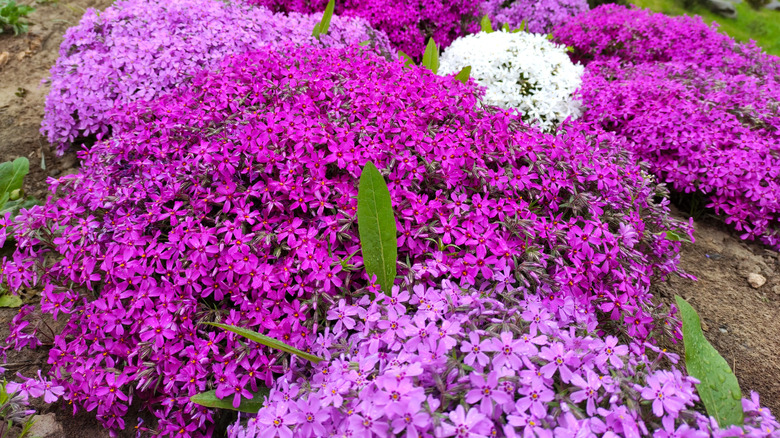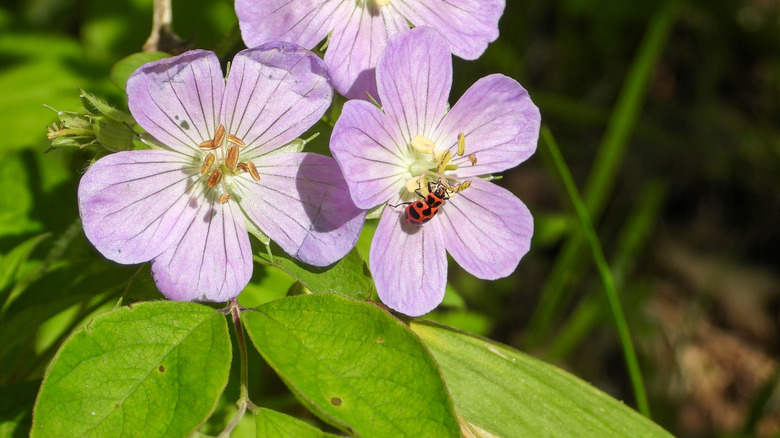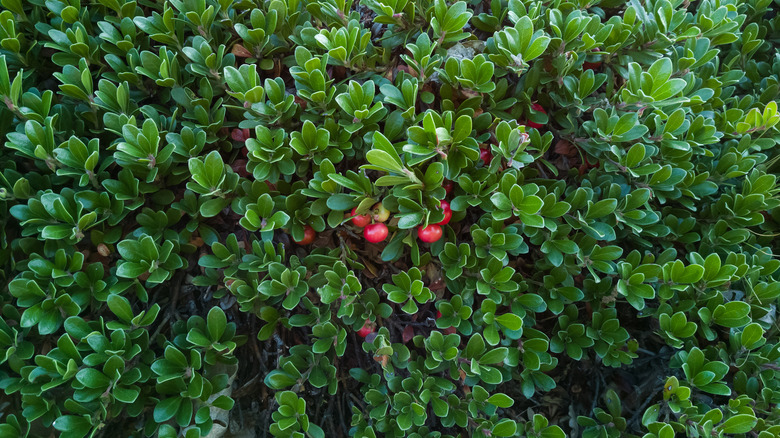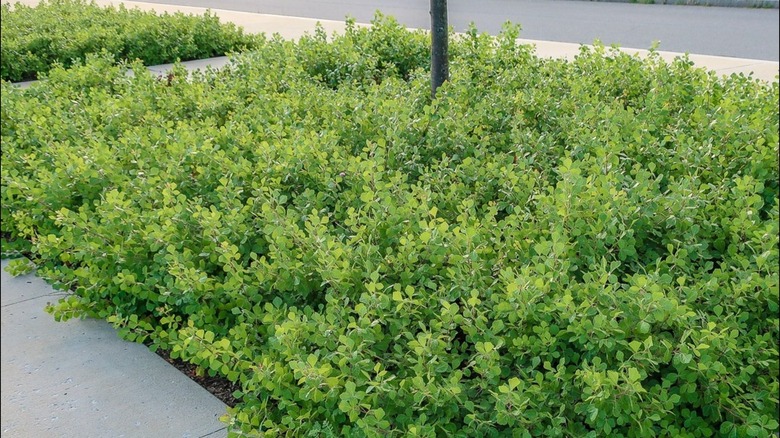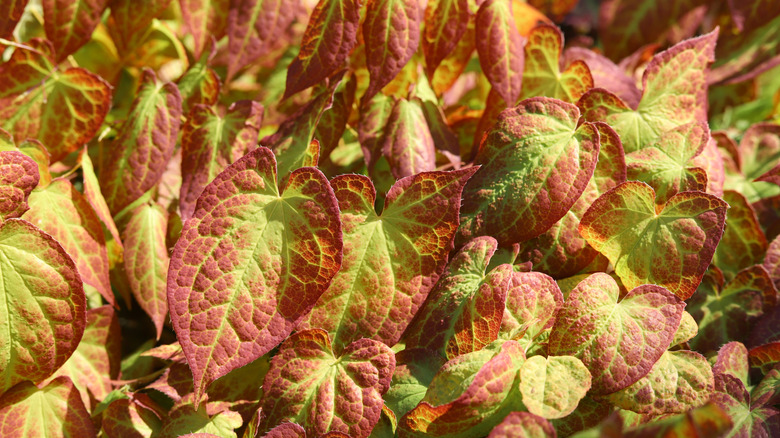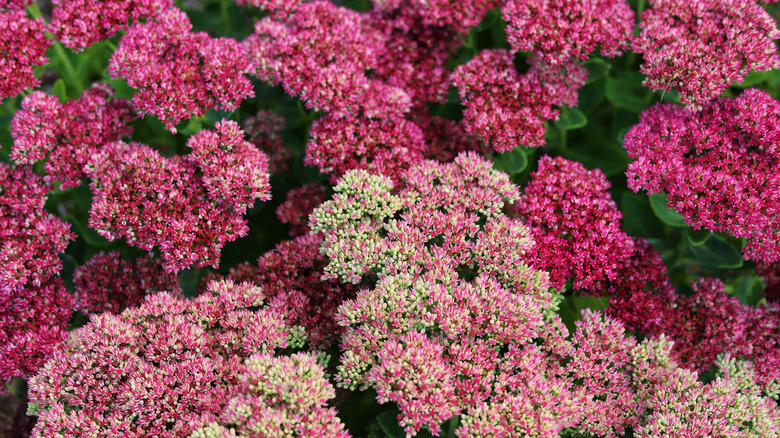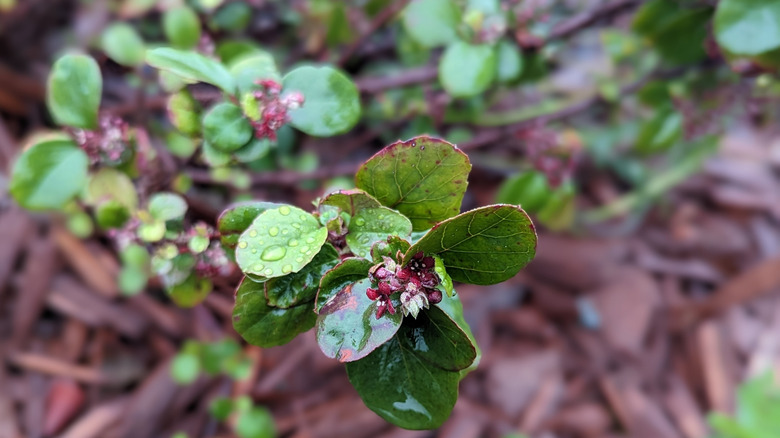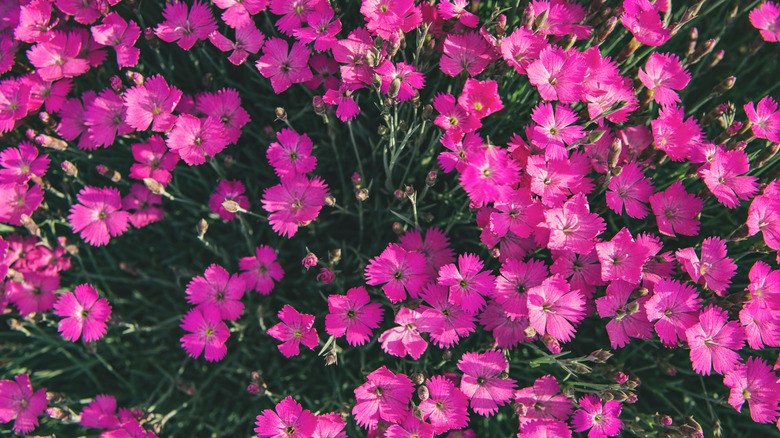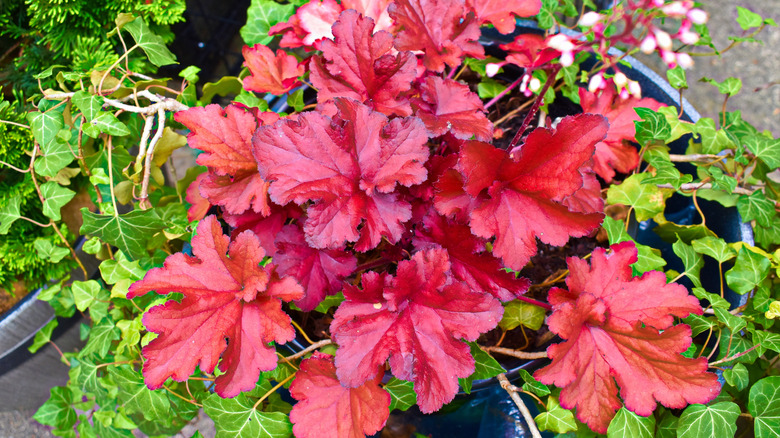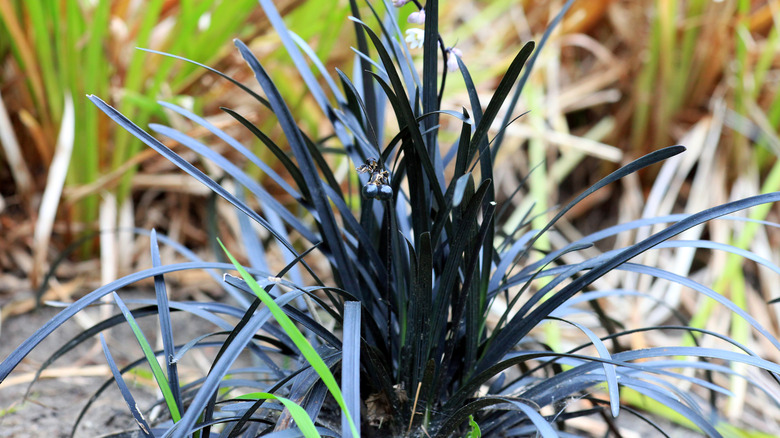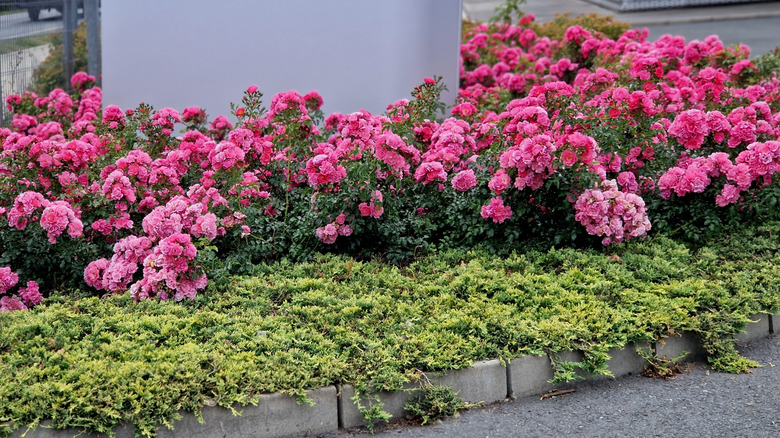11 Best Ground Covers For Flower Beds
Ground covers — low-growing plants that mat, sprawl, trail, or clump on the ground — play a valuable role in the landscape. They fill in gaps in flower beds, adding color, texture, and depth. Cascading down pavers or kissing the edge of walkways, they soften border edges and smooth the transition area between beds and paved, turf, or gravel areas. They also boost visual interest through their gorgeous flowers and leaves. Ground cover plants can also attract pollinators and other wildlife, while masking the dying bulb foliage or gangly perennial stems in your yard.
Besides being aesthetically pleasing, ground covers also assume functional roles. For instance, if they spread out like a carpet, they can outcompete unsightly weeds. Since plenty of ground covers hold on to the dirt well, they can help control leaching and soil erosion. The best part, though? You don't have to remember the myriad care requirements of diverse ornamentals, because ground covers typically entail little maintenance. In short, they're your gateway to establishing a visually arresting garden, especially if you're strapped for time. To enjoy these benefits, grow ground covers hardy to your USDA zone and filter them according to your site's conditions (think sun exposure, soil, and drainage) and the desired purpose. To aid your search, here's a quick roundup of some of the best ground covers for flower beds.
Moss phlox forms a dense flowering carpet that smothers weeds
Maintaining flower beds wouldn't be so difficult if weeds didn't invade them. But given the numerous things they can ride in on — like your shoes, lawn care equipment, wind, nursery transplants, bird droppings — weeds are prone to pop up in even the most well-manicured garden. While you can eliminate them using mulch, growing moss phlox or moss pink (Phlox subulata) is a prettier way to choke off weed seedlings once the plants have established. Creeping 3 feet across, moss phlox forms a thick, cushiony mat that turns into a veritable carpet of pink flowers when in bloom, adding even more color to your borders. Plus, it's evergreen, so it can keep weeds out throughout the year and be a source of greenery during winter.
To give your moss phlox the best chance of establishing, thriving, and flowering, pop the plants in areas receiving at least six hours of direct sunlight, or the mat will appear sparse. But if your summers tend to be hot and humid — particularly in Zone 9 or lower — give them dappled shade. Also ensure they don't get lost amongst taller ornamentals and shrubs. While good drainage is appreciated, moss phlox spreads regardless in infertile, stony, and gravelly soils. But look for disease-resistant cultivars like 'Fort Hill' or 'White Delight' if phytophthora and blight are an issue. Also, be prepared to fence the beds in rabbit-infested areas, as they adore its foliage.
Wild geranium is a fast-growing, flowering ground cover that's ideal for moist and shady border beds
Gardening in shade can be inconvenient. Soils take their sweet time drying out, which can limit planting choices, and shade can reduce flowering in ornamentals, making it hard to fill shady beds with color. Besides, as the snow thaws much later, such areas experience a shorter growth season and may even become hotbeds for moss or slugs. Luckily, you don't have to stick to boring ferns and hosta. Grow wild geraniums (Geranium maculatum), aka hardy geraniums, instead. They've got a natural proclivity for low-light conditions, surviving on just two hours of direct sun exposure. They can also persevere on elevated heights (upwards of 8,000 feet), making them popular in mountain garden beds. However, if forced — for instance, when you prune tree limbs for better structure and airflow — they'll tolerate more light. But you must simultaneously raise the irrigation frequency. Their roots thrive in moist soil and even tolerate occasionally flooded spots, making them perfect for shady flower beds that also tend towards dampness.
When massed in lightly shaded flower beds, wild geraniums stand out with their colorful white, pink, or red flowers (avoid blues as they merge in shadows). Your ornamentals will benefit from the increased presence of pollinators and beneficial insects, including bumblebees and syrphid flies. Other times, they spread out as low-growing deciduous clumps, effectively suppressing weeds. They're also deer- and drought-resistant.
Massachusetts kinnikinnick spreads out as a springy mat on sloped garden beds, stalling erosion
Sloped yard or hillside flower bed owners are no strangers to soil erosion. In fact, the steeper the gradient, the greater the likelihood that the soil will run off after rain (or irrigation), depriving plants of precious nutrients. For such cases, Massachusetts kinnikinnick (Arctostaphylos uva-ursi 'Massachusetts') is the perfect ground cover. Since the plants root deeply, they hold onto the earth really well, providing effective erosion control. Plus, they aren't known to be thirsty and are moderately drought-tolerant after they've fully established. So, you won't have to water too often, further reducing the risk of nutrient leaching. Moreover, Massachusetts kinnikinnick covers ground quickly, spreading nearly 15 feet across by maturity, although you can accelerate this process by planting them closer.
If you're looking for evergreen ground covers that provide stunning color all year round, Massachusetts kinnikinnick will definitely tick this box. In summer, the 1-foot-tall plant cradles light pink flowers, receiving ample attention from butterflies and hummingbirds. Its red berries attract birds in the fall and winter. You can even remove the ornate berries, along with their twigs, and hang them as Christmas decorations. For best results, plant the ground cover in partially or fully sun-exposed flower beds. Since it resists salt well, it may be used in borders neighboring roads or sidewalks in cold climates, and is hardy to Zone 2. Avoid growing Massachusetts kinnikinnick around heavy feeders (like peonies), because it doesn't like to be fertilized.
Tuck fragrant sumac 'Gro-Low' in flower beds to curb soil erosion
Another beautiful ground cover that is great for preventing soil erosion is 'Gro-Low,' a low-growing cultivar of fragrant sumac (Rhus aromatica). It establishes quickly, forming a 6-8 foot wide mat when fully mature. 'Gro-Low' plants send out runners which root wherever they touch the ground, helping to hold soil in place and minimize water runoff. Additionally, this ground cover produces underground stems, further strengthening its hold on the soil. This makes 'Gro-Low' useful in flower beds on slopes and hill sides where erosion is a recurring problem. Sloped sites are prone to drying or generally hold infertile soils, and 'Gro-Low' offers a fast way out to cover the exposed patches: It's highly drought tolerant and easily adapts to poor, shallow, and rocky soils if they drain well.
But that's not all. 'Gro-Low' is immensely popular with the local wildlife that flock to its berries from summer through the winter. Fortunately, deer and rabbits aren't a part of this party. Just be sure to plant both a male and a female specimen if you're looking forward to the fruiting. Grow 'Gro-Low' in full sun or partial shade in USDA Zones 3 through 9, and enjoy its eye-catching fall undertones of purple and orange.
Barrenwort can add beautiful color to shady borders and won't get munched down by deer
Deer can be a massive problem in woodland settings. They make meals of beautiful flowers, especially roses, and trample upon seedlings and juvenile ornamentals during evenings. Without adequate deterrence in place (think fences), your flower beds will become unsightly, putting all your effort, time, and money down the drain. However, you can reduce the frequency of such events by filling borders with deer-resistant plants like barrenwort (Epimedium spp.), also known as fairy wings. Both deer (and even rabbits) dislike their foliage.
Although barrenwort isn't the fastest-spreading ground cover and is unlikely to take over your plants. Its clumps sprawl slowly through rhizomes, forming a colony of wiry stems and heart-shaped leaves — even in dappled and heavy shade. In Northern areas of the U.S. barrenwort can also handle full sun conditions. Barrenwort offers plenty of varieties and cultivars with pink, red, or yellow blooms, as well as varying leaf colors that can add lots of interest to flower beds. Look for Mediterranean varieties if you prefer evergreen foliage, since the rest are deciduous. Another benefit of barrenwort is that it can withstand drought stress with ease, so you may plant it in xeric beds. However, if you're planting it in a sunny location in the northern ranges (Zone 5 and lower), it'll need regular watering. Barrenwort clumps must be separated every four years for vigorous growth.
Low-growing sedums can thrive in dry, infertile garden beds and provide a stunning show of flowers
If you're living in a wildfire-prone area, consider growing fire-resistant ground covers like stonecrops or sedum (Sedum spp.). As sedums are succulents and store water in their plant parts, they tend not to catch fire as quickly. Many sedum varieties are drought-tolerant, further adding to their utility. Upright sedums typically grow a couple of feet tall, but you get various low-growing cultivars that are great ground covers.
Aside from their fire-resistant benefits, sedums offer a host of other advantages. They attract butterflies and bees that aid the pollination of your flowers, but deer don't usually eat it. Speaking of flowers, some sedums are valued for their showy flower displays, while others sport eye-catching colors in their leaves, such as burgundy or yellow. If you plant a mix of varieties, they can be a source of color in your beds throughout the growing season, creating the perfect ground cover for year-round color in your garden. Sedums are also very low-maintenance and require minimal watering and fertilization. They tolerate partial to full sun and alkaline soils, but require good drainage to avoid root rot. Look for cultivars like 'Angelina,' 'John Creech,' and 'Lemon Coral,' or varieties like gold moss sedum (sedum acre) if you're keeping a water-wise or rock garden. To top things off, sedum is super hardy and able to grow in USDA Zones 3 through 8. Low-growing sedums sprawl and creep and each plant should form a roughly 2-foot-wide carpet that can overwhelm weeds that threaten your flowers. If the ground cover grows sparse, pinch its stems to promote bushier growth.
Evergreen currant is ideal for dry, shady garden beds under large trees
Does your garden receive little to no rainfall for months on end? Worse yet, does the temperature soar over 100 degrees Fahrenheit on a few atypical days? Under such cases, consider jumping on the 2025 landscaping trend that will save you money on your water bill: growing drought-tolerant plants. Hailing from California, evergreen currant (Ribes viburnifolium), or Catalina perfume, is an evergreen shrub that's often grown as a tall ground cover in dry sites. That's because its stems root wherever they touch the ground, easily extending over 6 feet wide. Pruning the stems occasionally promotes bushier growth, eventually creating a dense carpet.
Evergreen currant has a rare attribute in that it can handle both shade and dry soils. However, it's also adaptable. In UC Davis Landscape Plant Irrigation Trials, evergreen currant maintained vigorous growth throughout differing irrigation treatments. But you must plant them in partially or deeply shaded sites as the leaves can burn from excessive sun exposure. So, if you have a dry, shaded bed underneath a large tree, such as an oak, evergreen current is the perfect plant to try. It's not the showiest species, but its ability to thrive in dry shade and cover up bare areas can still improve the appearance of beds, and it does produce small pink flowers at the end of winter and into mid-spring. Evergreen currants also attract a legion of beneficial insects, along with bees and hummingbirds.
'Firewitch' dianthus can cover alkaline beds with masses of pink, pollinator-friendly blooms
Most ground covers grow best in soil pH levels 6.0 and 7.0, so they can easily uptake essential nutrients. While there are ways to make your soil more acidic, calcite soils can be particularly hard to amend as they can absorb added acidity over time, often returning to an alkaline pH. If you have alkaline-skewed soil in your garden beds, consider growing 'Firewitch' dianthus (Dianthus gratianopolitanus 'Firewitch') — a German carnation cultivar. Dianthus thrives in slightly alkaline soils as long as it's given ample sunlight. Though in hotter ranges (Zone 8), it can enjoy light afternoon shade. While it is more drought tolerant than other dianthus varieties, it will need watering if conditions stay dry. Incorporating compost or leaf mold into the soil can help with moisture retention, and applying gravel mulch or pea stones to the edges of plantings can help stop the upper layer of soil from drying out and prevent sand and dirt from splashing up and clinging to the foliage in hard rains.
If planted in drifts, 'Firewitch' dianthus can create an evergreen bluish-toned mat, muscling out weeds. Individual plants grow about 1 foot wide (and just as tall). Besides planting 'Firewitch' in swathes, you can also use individual plants to fill our bare patches in your borders and provide pops of color. This ground cover produces perfumed, magenta-pink flowers from spring through fall. The bright blooms can not only compliment your existing flowers, but also bring in vibrant butterflies to your garden beds. To keep the flushes coming, remove the spent blooms regularly. As a final cherry on top, deer dislike 'Firewitch' dianthus's foliage, making this one showy ornamental that's unlikely to become deer dinner.
Coral bells is a low-maintenance ground cover that can add clumps of color to shady flower beds
Coral bells or alum root (Heuchera spp.) is another ground cover that's easy to grow, and can add interest to shady garden beds. Hardy in USDA Zones 3 through 9, coral bells can be started with seeds, making them a budget-friendly option. Their primary draw is the colorful, textured, and variegated foliage in diverse patterns and hues like purple, red, and silver that couple exquisitely with ornamental flowers in garden beds and break up the "sea of green" that can so often happen in shady beds (as there are fewer flowering options for shaded sites). Plus, they're short, reaching just under 2 feet, allowing for layered plantings. Another draw? Coral bells might be of immense service if you're looking to attract your area's hummingbirds. Around summer, they burst out in red, orange, or pink bell-shaped flowers that hummers devour for nectar. Aside from the aesthetic benefits, hummingbirds assist with pollination — something your existing flowers will appreciate.
Coral bells aren't too care-hungry. Just plant them in lightly shaded spots, or ensure they only receive morning sun, and they're good to go (excessive sun can fade their foliage). If the soil isn't fertile, you can apply an annual feeding of a slow-release fertilizer or compost, and be sure to water regularly while plants get established and during hot and dry summers, as most varieties aren't drought tolerant. But, don't overwater either, as their roots can rot in water-logged soils. Mulching the beds may be necessary up north to stave off winter damage. As coral bells lose their vigor in four years (or less), you must separate their clumps to keep the beds attractive.
Black mondo grass adds moody color and textural contrast to flower beds
The goth in you will positively rejoice at the sight of black mondo grass or black lily turf (Ophiopogon planiscapus 'Nigrescens'). Supporting a mass of near-black blades (that some assert are dark purple), black mondo grasses establish 1-foot-wide clumps that are sure to draw the eye. Besides the evergreen foliage, these ornamental grasses put out clouds of lilac-white blooms and purple berries, adding year-round interest. For these reasons, black mondo grass is often planted in garden beds as a ground cover, where its dark color and leathery texture contrasts dramatically with surrounding flowers. You can interplant it within flower beds, or site black mondo grass in bare areas at the edge of borders, where its slender blades can cascade down, defining pathways and sidewalks. Alternatively, black mondo grass may be used to cover ugly tree roots of shade trees like Japanese maples – something that's often a challenge in shady beds, where most ornamentals won't thrive so close to a tree's trunk.
Black mondo grass is easy to maintain, as it attracts few pests or diseases. However, slugs may track the foliage in humid climates. Black mondo grass holds up well against salt and drought, but isn't too cold hardy, necessitating mulch during Zone 6 winters. Another thing to bear in mind is that black mondo grass grows slowly, so you should space plants about 4 inches apart to ensure the area fills in quickly.
Grow roses as ground covers to cover large bare areas and have your beds bursting with blooms
For the ultimate flower bonanza, consider incorporating ground cover roses in your flower beds. Perfect for quickly spreading over large bare areas, these low-growing roses will quickly establish an enviable fragrant, flowering cover. Many cultivars remain evergreen year-round, especially in warmer climates, depriving weeds of opportunities to spring a rude surprise come spring. Since ground cover roses can grow up to 3 feet tall and sprawl out, you need to be intentional about their placement. This is especially important if you have shorter plants and don't want them to be smothered.
Unlike other rose types, ground cover roses aren't garden divas and are relatively easy to maintain. For instance, the Anthony Tesselaar Plants' 'Flower Carpet' series are resistant against common rose diseases, lowering care requirements. They can also survive dry periods, and pruning is not mandatory for abundant blooms. Other ground cover cultivars include 'Baby Blanket,' 'Rosy Carpet,' 'Sun Runner,' 'Nitty Gritty,' 'Red Ribbons,' and Memorial roses (Rosa wichuraiana).
